2020-2021学年七年级英语电子导学案:Unit-8-第三课时
- 格式:doc
- 大小:82.50 KB
- 文档页数:2
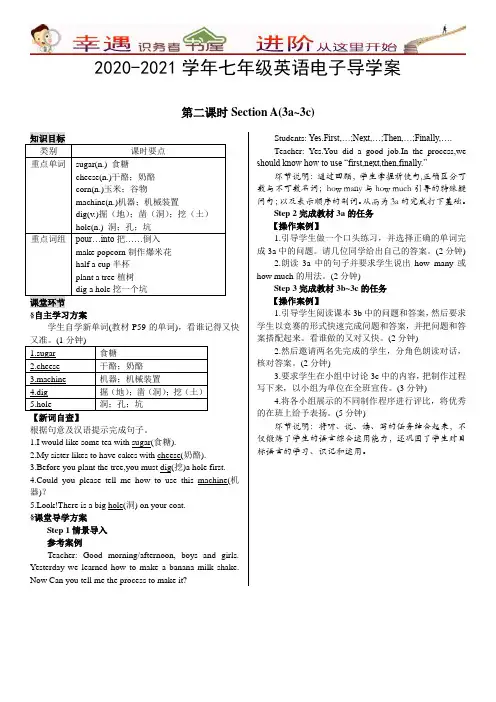
2020-2021学年七年级英语电子导学案第二课时Section A(3a~3c)知识目标类别课时要点重点单词sugar(n.) 食糖cheese(n.)干酪;奶酪corn(n.)玉米;谷物machine(n.)机器;机械装置dig(v.)掘(地);凿(洞);挖(土)hole(n.) 洞;孔;坑重点词组pour…into把……倒入make popcorn制作爆米花half a cup半杯plant a tree植树dig a hole挖一个坑课堂环节§自主学习方案学生自学新单词(教材P59的单词),看谁记得又快1.sugar 食糖2.cheese 干酪;奶酪3.machine 机器;机械装置4.dig 掘(地);凿(洞);挖(土)5.hole 洞;孔;坑【新词自查】根据句意及汉语提示完成句子。
1.I would like some tea with sugar(食糖).2.My sister likes to have cakes with cheese(奶酪).3.Before you plant the tree,you must dig(挖)a hole first.4.Could you please tell me how to use this machine(机器)?5.Look!There is a big hole(洞) on your coat.§课堂导学方案Step 1情景导入参考案例Teacher: Good morning/afternoon, boys and girls. Yesterday we learned how to make a banana milk shake. Now Can you tell me the process to make it?Students: Yes.First,…;Next,…;Then,…;Finally,….Teacher: Yes.You did a good job.In the process,we should know how to use “first,next,then,finally.”环节说明:通过回顾,学生掌握祈使句,正确区分可数与不可数名词;how many与how much引导的特殊疑问句;以及表示顺序的副词。
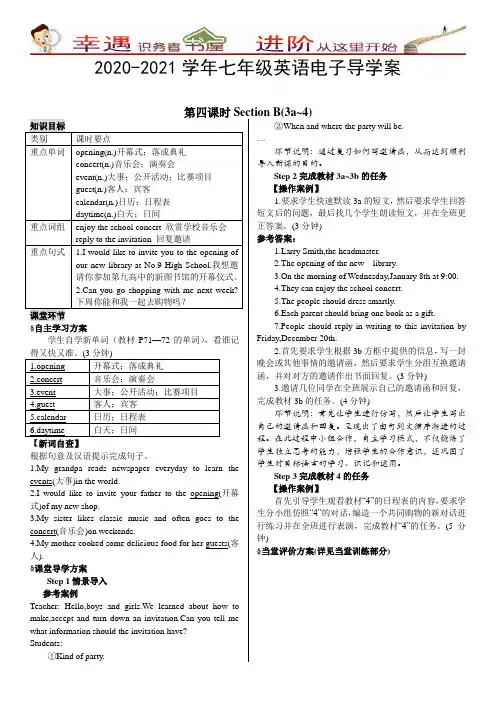
2020-2021学年七年级英语电子导学案知识目标类别课时要点重点单词opening(n.)开幕式;落成典礼concert(n.)音乐会;演奏会event(n.)大事;公开活动;比赛项目guest(n.)客人;宾客calendar(n.)日历;日程表daytime(n.)白天;日间重点词组enjoy the school concert 欣赏学校音乐会reply to the invitation 回复邀请重点句式 1.I would like to invite you to the opening of our new library at No.9 High School.我想邀请你参加第九高中的新图书馆的开幕仪式。
2.Can you go shopping with me next week?下周你能和我一起去购物吗?课堂环节§自主学习方案学生自学新单词(教材P71—72的单词),看谁记1.opening 开幕式;落成典礼2.concert 音乐会;演奏会3.event 大事;公开活动;比赛项目4.guest 客人;宾客5.calendar 日历;日程表6.daytime 白天;日间【新词自查】根据句意及汉语提示完成句子。
1.My grandpa reads newspaper everyday to learn the events(大事)in the world.2.I would like to invite your father to the opening(开幕式)of my new shop.3.My sister likes classic music and often goes to the concert(音乐会)on weekends.4.My mother cooked some delicious food for her guests(客人).§课堂导学方案Step 1情景导入参考案例Teacher: Hello,boys and girls.We learned about how to make,accept and turn down an invitation.Can you tell me what information should the invitation have?Students:_______________①Kind of party.②When and where the party will be.…环节说明:通过复习如何写邀请函,从而达到顺利导入新课的目的。
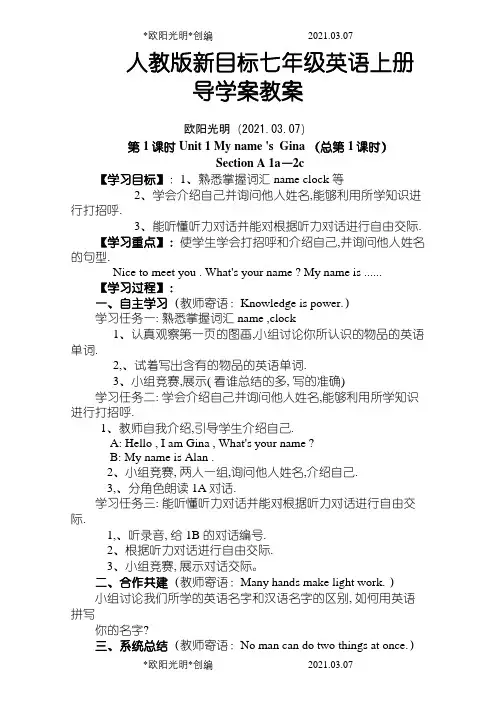
人教版新目标七年级英语上册导学案教案欧阳光明(2021.03.07)第1课时Unit 1 My name 's Gina (总第1课时)Section A 1a—2c【学习目标】:1、熟悉掌握词汇name clock 等2、学会介绍自己并询问他人姓名,能够利用所学知识进行打招呼.3、能听懂听力对话并能对根据听力对话进行自由交际.【学习重点】:使学生学会打招呼和介绍自己,并询问他人姓名的句型.Nice to meet you . What's your name ? My name is ......【学习过程】:一、自主学习(教师寄语:Knowledge is power.)学习任务一: 熟悉掌握词汇name ,clock1、认真观察第一页的图画,小组讨论你所认识的物品的英语单词.2,、试着写出含有的物品的英语单词.3、小组竞赛,展示( 看谁总结的多, 写的准确)学习任务二: 学会介绍自己并询问他人姓名,能够利用所学知识进行打招呼.1、教师自我介绍,引导学生介绍自己.A: Hello , I am Gina , What's your name ?B: My name is Alan .2、小组竞赛, 两人一组,询问他人姓名,介绍自己.3,、分角色朗读1A对话.学习任务三: 能听懂听力对话并能对根据听力对话进行自由交际.1,、听录音, 给1B 的对话编号.2、根据听力对话进行自由交际.3、小组竞赛, 展示对话交际。
二、合作共建(教师寄语:Many hands make light work. )小组讨论我们所学的英语名字和汉语名字的区别, 如何用英语拼写你的名字?三、系统总结(教师寄语:No man can do two things at once.)1,、归纳你所学到的问候语.2、自己编写一个打招呼并询问姓名的小对话.四、诊断评价(一)单项选择.1. _______your name ? My name is Gina .A. WhatB.What'sC. WhoD. which2. Good morning , Miss Wang ! _____________!A. HelloB.HiC. Nice to meet youD. Good morning3. I _______Sally , What______ your name ?A. am ,isB. is , amC. is , isD.am, am4. ______name is Li lei .A. IB. I amC. MyD. you5.— _______, What's your name ?— John Green .A. HiB. OkC. sorryD. Excuse me(二)写出下列单词的完全形式, 并写出汉语意思.I'm _________ __________ what's __________ ________name 's ___________ __________(三)写出下列单词.时钟 _______ 我的 ________ 你的___________ 名字_______遇见_________(四)尝试翻译下列句子.1.见到你很高兴. _________________________________.2.我叫王小雨. ____________________________________.3.你叫什么名字? ____________________________________(五)根据情景补全对话.A: Good afternoon !B: ____________________!A; I ______Lucy . _________your name ?B: My ______ is Jim . Nice to ______you !A: _______________________________.五、【课后反思】(教师寄语:Never do things by halves)第2课时Unit 1 My name 's Gina.(总第2课时)Section A (1a—2c)【学习目标】:1、熟练掌握本课6个单词.2、学会询问他人姓名及介绍他人姓名.3、能听懂有关谈论他人姓名的对话并进行自由交际.【学习重点】:询问他人姓名及介绍他人姓名的句型.一、自主学习(教师寄语:Knowledge is power.)学习任务一: 熟练读写本课6个单词.1.个人自渎,记忆本课单词.2.小组互相检查单词读写情况.3.根据汉语写出下列英语单词并展示.学习任务二: 运用句型:What's his / her name?His / Her name is .... 进行自由交际.1.小组合作,理解并熟读下列短语,并写出汉语意思.my nane ( ) your name ( )his name ( ) her name ( )2.个人理解下列对话,并且两人合作练习.A:Hello! What's your name?B:My name is Gina.A:Nice to meet you.B:Nice to meet you,too.A:What's her name?B:Her name is Jenny.3.小组合作,练习自己的对话.4. 对抗组开展竞赛,展示自己的对话.学习任务三: 听听力完成2a,2b.1.个人看图,理解四幅图画,思考图画中人是在谈论他人还是对方.2.听听力,给四幅图画编号.3. 小组为单位,熟读2b中的名字。
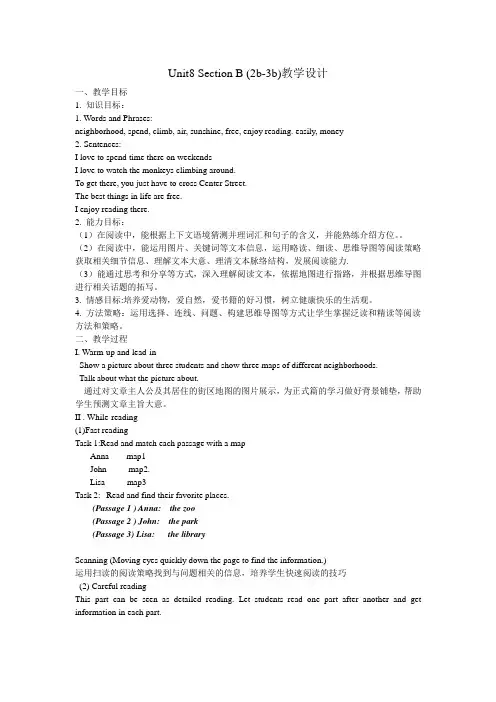
Unit8 Section B (2b-3b)教学设计一、教学目标1. 知识目标:1. Words and Phrases:neighborhood, spend, climb, air, sunshine, free, enjoy reading. easily, money2. Sentences:I love to spend time there on weekendsI love to watch the monkeys climbing around.To get there, you just have to cross Center Street.The best things in life are free.I enjoy reading there.2. 能力目标:(1)在阅读中,能根据上下文语境猜测并理词汇和句子的含义,并能熟练介绍方位。
(2)在阅读中,能运用图片、关键词等文本信息,运用略读、细读、思维导图等阅读策略获取相关细节信息、理解文本大意、理清文本脉络结构,发展阅读能力.(3)能通过思考和分享等方式,深入理解阅读文本,依据地图进行指路,并根据思维导图进行相关话题的拓写。
3. 情感目标:培养爱动物,爱自然,爱书籍的好习惯,树立健康快乐的生活观。
4. 方法策略:运用选择、连线、问题、构建思维导图等方式让学生掌握泛读和精读等阅读方法和策略。
二、教学过程I. Warm-up and lead-inShow a picture about three students and show three maps of different neighborhoods.Talk about what the picture about.通过对文章主人公及其居住的街区地图的图片展示,为正式篇的学习做好背景铺垫,帮助学生预测文章主旨大意。
II . While-reading(1)Fast readingTask 1:Read and match each passage with a mapAnna map1John map2.Lisa map3Task 2:Read and find their favorite places.(Passage 1 ) Anna: the zoo(Passage 2 ) John: the park(Passage 3) Lisa: the libraryScanning (Moving eyes quickly down the page to find the information.)运用扫读的阅读策略找到与问题相关的信息,培养学生快速阅读的技巧(2) Careful readingThis part can be seen as detailed reading. Let students read one part after another and get information in each part.Task3:Read passage1carefully,then answer the questions. And find out the key words or sentences that help you find the answer.(1)What does Anna like doing in the zoo?(2)Does Ann think monkeys are like people?Why?(3)What do you think of Anna?(4)How does Anna get to the zoo from her home?Task4: Read passage2 and fill in the blanks. And find out the key words or sentences that help you find the answer.(1) John often exercises , because(2) He thinks the best things in life are(3) What’s the best thing in your life that is free? Why?Task5: Read passage3carefully,then answer the questions. And find out the key words or sentences that help you find the answer.(1)Where does she live?(2)What’s her favorite place? Why?(3)How does she get to the library?III. After readingTask6: Find and think (discusstion)Why do they think their neighborhoods are great?Task7: Finish a passage according the texts.IⅤ.Language points1. neighborhood 意为“附近;街区;街坊”e.g. 在附近有一家中国餐馆。
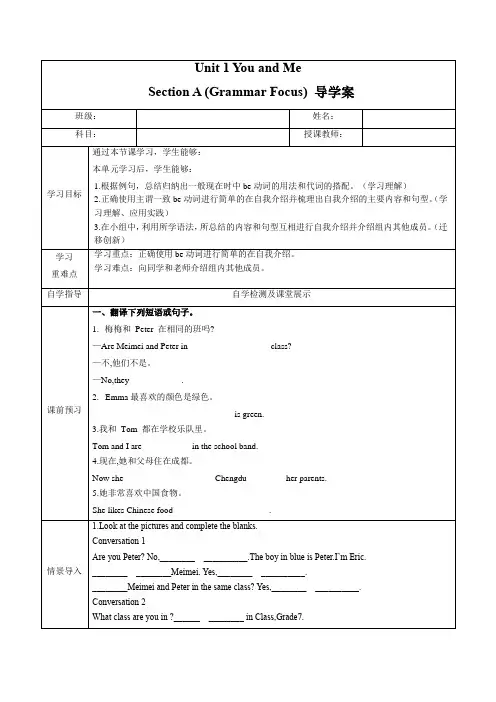
1.What kind of questions are they?__________________________________________________2.Read the sentences and circle the verbs.Then write am,is or are next to the personal pronouns.3.Do you find the rules about the use of be verbs ?________________________________________________________________________4.Practice 将下列主语与be动词搭配5.含有be动词的句子怎么变成一般疑问句?I am a student.________________________________________________________________6.Practice 将下列句子改为一般疑问句,并做肯定和否定回答。
①She is Linda._____________________________________________________________________________②I am from China._____________________________________________________________________________Introduce one of your new friends to a partner.一、用am,is,are填空1.What kind of questions are they?含有be动词的一般疑问句/ 由特殊疑问词引导的特殊疑问句2.Read the sentences and circle the verbs.Then write am,is or are next to the personal pronouns.3.Do you find the rules about the use of be verbs ?I(我)用am, you(你)用are,is 跟着she (她),he(他),it(它),单数一律用is,复数一律都用are。
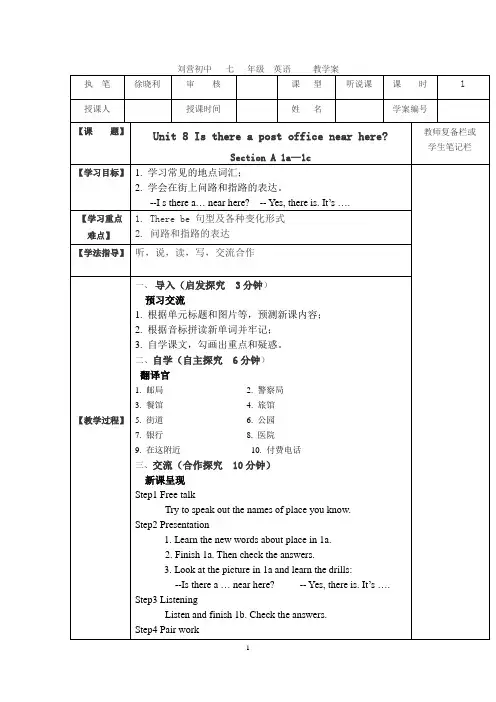

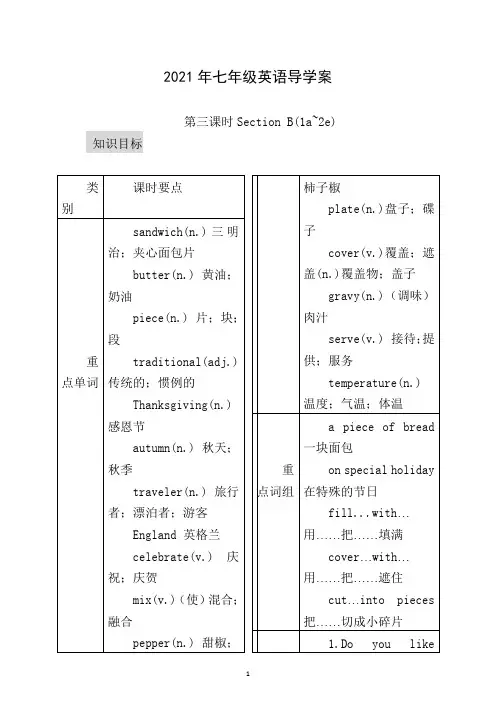
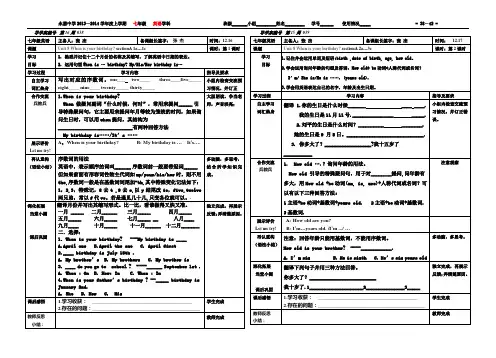
IV、将左栏的节日与右栏的日期相连。
1. May Day2. Women’s Day3. Children’s Day4. Teacher’s Day5. National Day6. Christmas Day7. Mother’s Day8. Father’s Day9. New Year’s Day10. Tree Planting Day A. September 10thB. in JuneC. December 25thD. March 8thE. in MayF. March 12thG. January 1stH. May 1stI. October 1stJ. June 1stUnit 8 When is your birthday?检测题(时间:45分钟;满分:100分)I、单项填空(每小题1分,满分20分)1.My birthday is .A.June fourthB.June forthC.July four2.—Happy birthday to you,Gina!—.A.All rightB.Thank youC.That’s all right3. —Look!There are so many people in the park.—Nobody likes to stay at home Sunday morning.A.inB.onC.at4.—When is your school’s contest?—It’s May 25th.A.inB.onC.atD.to5.There are months in a year.The month of a year is December.A.twelve;twelveB.twelfth;twelfthC.twelve;twelfth6.Our school has Art Festival every year.A.aB.anC.the7. July 1st of this year is birthday of CPC(中国共产党).A.ninetyB.the ninetyC.the ninetieth8.I really want to watch the basketball .A.tripB.batC..game9.—?—I’m fourteen.A.How are youB.When are youC. How old are you10. This is room.The twin sisters like it very much.A.Lucy’s and Lily’sB.Lucy’s and LilyC.Lucy and Lily’sII、完形填空(每小题1.5分,满分15分)Gina is 14 1old. 2 birthday is November 3 . She likes playing 4and 56.Her sister,Amma,is 12 years old. Her birthday is 7eighth. She likes 8books.She likes blue. Her sweater and 9 10 blue.She is very lovely(可爱的).1.A.year B.years old C. year old2.A.He B.Her C..His3.A.twelve B.tenth C.ten4.A. basketball B.a basketball C.the basketball5.A.play B.playing C.plays6.A.piano B.the piano C.pianos7.A.third B.seven C.May8.A.reading B.looking C.seeing9.A.pant B.pants C.a pant10.A.is all B..are all C.all areII、阅读理解(每小题2分,满分20分)AToday is November 8th. It’s Gina’s birthday. She is twelve. Jim,Kate and Bill are her friends. They want to buy some presents(礼物)for Gina. They go to the shop near the school. There are a lot ofthings in the shop. They buy a big cake,two boxes of color pencils, apencil box and some nice exercise books. They want to buy twodolls(玩具)for Gina. But all the dolls are too dear (贵的).1.How old is Gina today?A.12.B.13.C.11. .2.Gina has friends.A.threeB.fourC.two3.is near the school.A.Their homeB.A factoryC.The shop4.They buy _________ for Gina.A. a big cakeB. two boxes of color pencilsC. a pencil box and some nice exercise booksD.A,B and C5.When is Gina’s birthday?A. Today.B. November 8th.C. Sorry,I don’t know.BBirthdays of my familyThere are five people in my family.My (1) birthday is inJanuary.We (2)看电视on her birthday and eat a big birthday cake(蛋糕).March is the (3) month of a year.In my family,we havethree birthdays in March.(4)My sister’s birthday is on March6th.My birthday is on March 16th.My grandfather’s birthday is inMarch, too. My father’s birthday is in December. It’s on (5)12月26日.根据短文内容,完成下列任务。
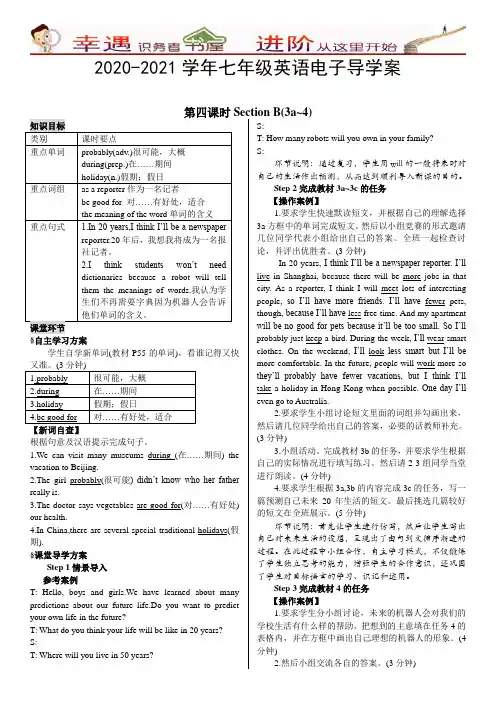
2020-2021学年七年级英语电子导学案Section B(3a~4)知识目标类别课时要点重点单词probably(adv.)很可能,大概during(prep.)在……期间holiday(n.)假期;假日重点词组as a reporter作为一名记者be good for 对……有好处,适合the meaning of the word单词的含义重点句式 1.In 20 years,I think I’ll be a newspaperreporter.20年后,我想我将成为一名报社记者。
2.I think students won’t needdictionaries because a robot will tellthem the meanings of words.我认为学生们不再需要字典因为机器人会告诉他们单词的含义。
课堂环节§自主学习方案学生自学新单词(教材P55的单词),看谁记得又快1.probably 很可能,大概2.during 在……期间3.holiday 假期;假日4.be good for 对……有好处,适合【新词自查】根据句意及汉语提示完成句子。
1.We can visit many museums during (在……期间) the vacation to Beijing.2.The girl probably(很可能) didn’t know who her father really is.3.The doctor says vegetables are good for(对……有好处) our health.4.In China,there are several special traditional holidays(假期).§课堂导学方案Step 1情景导入参考案例T: Hello, boys and girls.We have learned about many predictions about our future life.Do you want to predict your own life in the future?T: What do you think your life will be like in 20 years? S:________________________________T: Where will you live in 50 years? S:_______________________________T: How many robots will you own in your family?S:_______________________________环节说明:通过复习,学生用will的一般将来时对自己的生活作出预测,从而达到顺利导入新课的目的。
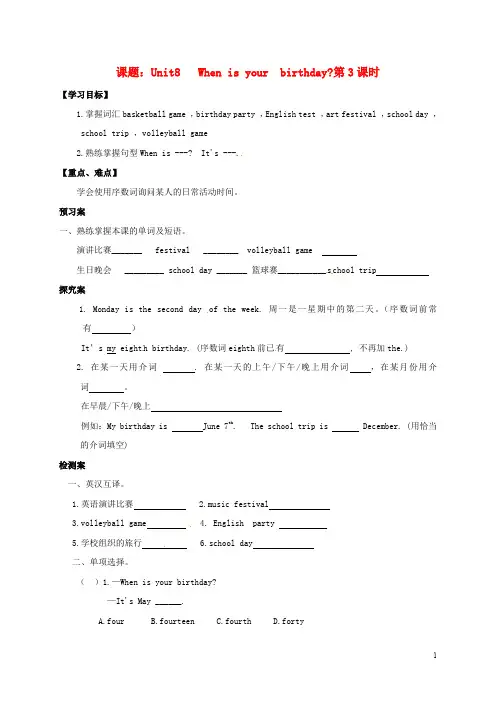
课题:Unit8 When is your birthday?第3课时【学习目标】1.掌握词汇basketball game ,birthday party ,English test ,art festival ,school day ,school trip ,volleyball game2.熟练掌握句型When is ---? It's ---.【重点、难点】学会使用序数词询问某人的日常活动时间。
预习案一、熟练掌握本课的单词及短语。
演讲比赛_______ festival ________ volleyball game生日晚会 _________ school day _______ 篮球赛___________s chool trip 探究案1. Monday is the second day of the week. 周一是一星期中的第二天。
(序数词前常有)It’s my eight h birthday. (序数词eighth前已有 , 不再加the.)2. 在某一天用介词 . 在某一天的上午/下午/晚上用介词,在某月份用介词。
在早晨/下午/晚上例如:My birthday is June 7th. The school trip is December. (用恰当的介词填空)检测案一、英汉互译。
1.英语演讲比赛2.music festival3.volleyball game4. English party5.学校组织的旅行6.school day二、单项选择。
()1.—When is your birthday?—It's May ______.A.fourB.fourteenC.fourthD.forty( ) 2.August is the _____month of the year .A.eighthB.ninthC.eightD.nine( ) 3.New Year's Day (元旦) is on January ______.A.1thB.1stC.1rdD.2nd( ) 4.Sunday is the ____day of the week.A.firstB.secondstD.third( ) 5.December is the ______month of the year.A.twelveB.tenthC.twelvethD.twelfth( ) 6. —Do you have a School trip at your school ?—_______.A.Yes,it is.B.Yes,we do.C.Yes,we does.D.Yes,it does.( ) 7.—_____is your aunt ? She is thirty.A.WhenB.When oldC.How oldD.How( ) 8.—Happy Birthday to you ! —________.A.That's all rightB.The same to you.C.Thank youD. That's OK. ( ) 9.—When is ____ birthday.—It's November 11th.A.SallysB.SallyC.Sally'sD.Sally i s( ) 10.Our school has an art festival _____ October 16 each year.A.inB.onC.atD.for三.用所给单词的适当形式填空。
Unit 8 Pets1.使学生掌握本单元掌握Comic strip—Task重要的短语搭配与重点词汇的意思与运用;2.对单元重点句型能够细致的理解,并能模仿句型进行写作;3.能够将每个知识点灵活地运用到单项选择和词汇运用等基础题型当中。
【聚焦中考】:Unit8 必考知识点汇编考点一:考查bring和take词义辨析Bring me something to eat.给我拿些吃的东西来。
(教材第92页)➢中考链接—Must I ______ my camera, Mary?—No, you ______. Don’t worry. I’ll take one myself.A. bring, can’tB. take, mustn’tC. take, needn't【答案】C【解析】bring表示“拿来,带来”,take表示“拿走,带走“。
对含有must的问句作否定回答,应用needn’t,根据句意,故选C。
考点二:考查形容词最高级的用法My dog is the cleverest animals of all.所有动物中我的狗最聪明。
(教材第94页)➢中考链接My son is only 12 years old, but he is ______ in our family. He grows so fast.A. tallB. tallerC. tallestD. the tallest【答案】D【解析】本题考查形容词最高级的用法。
根据句意“我的儿子只有12岁,但他在我们家最高”可知,表示在三者或三者以上中“最……”应用最高级形式,并且其前应加冠词the,故选D。
考点三:考查非谓语动词的用法Goldfish are quiet and easy to look after.金鱼很安静,很容易照顾。
(教材第98页)➢中考链接Paul made a nice cage ____ the little sick bird till it could fly.A. keepB. keptC. keepingD. to keep【答案】D【解析】本题考查非谓语动词的用法。
2020-2021学年七年级英语电子导学案Unit 1 Where did you go on vacation?单元总览类别课程标准要求掌握的项目单元话题Discuss past events and learn Indefinite pronouns: In this unit, students learn to understand and useIndefinite pronouns. They also learn to listen, talk and read about past events.重点单词1.anyone (adj.)2.anywhere(adv.)3.wonderful(adj.)4.few(adj.&pron.)5.most(adj. ,adv.&pron.)6.something(pron.)7.nothing(pron.)8.everyone(pron.)9.myself(pron.)10.yourself(pron.)11.hen(n.)12.pig(n.)13.seem(v.)14.bored(adj.)15.someone(pron.)16.diary(n.)17.activity(n.)18.decide(v.)19.try(v.&n.)20.bird(n.)21.bicycle(n.)22.building(n.)23.trader(n.)24.wonder(v.)25.difference(n.)26.top(n.)27.wait(v.)28.umbrella(n.)29.wet(adj.)30.below(prep.&adv.)31.enough(adj.&adv.)32.hungry(adj.)33.as(adv.)34.hill(n.)35.duck(n.)36.dislike(v.&n.)重点词组1. go on vacation2. stay at home3. go with4. play volleyball5. go out6. take photos7. of course8. have a good time9. go shopping10. taste good11. in the countryside12. a lot of13. feel like14. because of15. find out16. walk up to17. go on18. come up19. make notes重点句式1.—Where did you go on vacation?—I went to the mountain.2.—Oh, really? Did you go with anyone?—Yes, I went with my mother.3. ---How was the food?----Everything tasted really good.4. I wonder what life was like here in the past.5. What a difference a day makes!6. And because of bad weather, we couldn’t see anything below.7. How was the weather?8. How did you feel about the trip?9. It was so beautiful that we forgot about the last five hours!单元语法Indefinite pronouns—anyone, anywhere, something, anything, everything, anyone, nothing, no one 课时分解第一课时Section A(1a ~ 2d)知识目标类别课时要点重点单词anyone adj.任何人anywhere adv.在任何地方wonderful adj.精彩的;绝妙的few adj.&pron.不多;很少most adj. adv. &pron.最多;大多数重点词组go on vacation 度假stay at home 呆在家go with…和…一起play volleyball打排球go out出去take photos照相quite a few相当多重点句式1.—Where did you go on vacation?你在哪度的假?—I went to the mountains.我去山上了。
2020-2021学年七年级英语电子导学案第四课时Section B(3a~4)知识目标类别课时要点重点词组possible solutions 可行的解决方案school clean-up 学校大扫除重点句式—What will you do if you visit an oldpeople’s home?如果造访一位老人的家,你将怎么做?—If I do that,I’ll bring the old peoplesome flowers.如果我那样做,我将给老人带一些花。
课堂环节§自主学习方案【句型复习】1.—I think I’ll take the bus to the party.我想我将乘公汽去晚会。
—If you do,you’ll be late.如果你这样做,你会迟到的。
2.What will happen if they have the party today?如果他们今天举办晚会将会怎样?3.If I go to college,I’ll never become a great soccer player.如果我去上大学,我将永远都不能成为一名伟大的足球运动员。
4.If people have problems,they should get advice from an expert.如果人们遇到困难,他们应该向一位专家征求意见。
句型转换。
1.The teacher will get angry if you are late.(改为一般疑问句)Will the teacher get angry if you’re late?2.Work hard,or you’ll not pass the e xam.(改为同义句)①If you don’t work hard,you’ll fail the exam.②You’ll fail the exam unless you work hard.3.Mr. Black makes a living by growing vegetables.(对画线部分提问)How does Mr. Black make a living ?4. Will you please not close the window?(改为祈使句) Don’t close the window, please.§课堂导学方案Step 1情景导入参考案例Teacher: Hello,boys and girls.We learned about how to get advice when we have problems.Can you tell me what you often do when you have problems?Students:________________________①I often tell it to my best friends.②I often get help from my friends.…Teacher: Do you often talk to your friends or your parents when you have worries?Do your friends share their worries with you ?How do you often help them when they have problems?Next,in this lesson,we will learn to give them some advice.环节说明:通过复习如何用if条件从句提出建议,从而达到顺利导入新课的目的。
2021年最新人教版七年级英语下册全册导学案Unit 1 Can you play the guitar?Section A 1a ― 1c (P1)* 教师寄语:Never do things by halves. 做事不要半途而废。
【学习目标】:1. 掌握表示爱好的单词.2.熟练的谈论表示能力的话题,以及自己的意愿.【学习重点】:学会谈论自己或别人的能力. 【体验学习】:1. 情态动词can小结:后面总是接动词原形,没有人称和数的变化。
意思是�D能,会‖。
用法口诀:情态can表能力,和行为动词不分离。
不管主语如何变,can的模样永不变。
只要出现动词can,动词原形后面站。
一般疑问can提前,否定can后not添。
2. play的用法小结: play与体育、棋类词语连用时,不加定冠词the eg: play basketball, play chess, play cards play与乐器类词语连用时要加定冠词theeg: play the guitar,play the piano play the drum,play the violin 【课堂导学】:学习任务一、认读并书写本课单词1,个人自读,记忆单词,小组互相检查读写情况 2. 默写下列单词并展示。
弹吉他__________ 跳舞_________游泳__________ 唱歌_________ 下国际象棋______ 画画_________ 说英语______________________ 3.小组内核对答案4.完成1a 将单词与图画匹配学习任务二、学会谈论自己的能力并询问他人的能力。
1.听录音完成1b排序。
2.理解并复述听力对话并和你的伙伴编新对话。
3.完成1c, 练习下面的对话:Can you---? Yes, I can. No, I can‘t 学习任务三、合作探讨1.试翻译以下短语,并讨论有什么不同?弹吉他__________________ 踢足球___________________ 2.讨论如何询问第三人称能力的句型---Can he sing? ---Yes, he can. / No, he can't. ---Can Tom speak English? ---Yes, he can. / No, he can't.【自主检测】:I.精挑细选1. Can you ________ English? A. speak B. talk C. say2. Can he__________ basketball? A. play B. plays C. playing 3. My brother want_______ the chess club. A. join B. to join C. joins4. Mary can play the chess________ she can't swim. A. and B. or C.but5. His brother plays _______ piano every day.A. /B. aC. the II.翻译官说英语_____________ 弹吉他_____________ 象棋俱乐部__________ 下象棋______________ 英语俱乐部_____________ 音乐俱乐部__________ 美术俱乐部___________ 游泳俱乐部_____________ 参加___________ Ⅲ. 补全对话A. Can you ___________(唱歌)?B. Yes, I ________. Can you _________(游泳)? A. No, I want to join_______________(象棋俱乐部). B. I don't like ______________(象棋) A. Whatclub do you want to __________?B. I want to join __________________(游泳俱乐部) 【快乐链接】英汉对对碰:Match each word with the right Chinese meaning. guitar 游泳sing 吉他 swim 跳舞 dance 画画draw 唱歌【学习体会】chess 说、说话 speak 国际象棋 join 说英语 club 参加、加入 speak English 俱乐部、社团成功&收获: 失败&不足:Unit 1 Can you play the guitar?Section A 2a― 2d (P2)* 教师寄语:Never do things by halves. 做事不要半途而废。
2020-2021学年七年级英语电子导学案
第三课时Section B(1a~2e)
知识目标
类别课时要点
重点单词sandwich(n.)三明治;夹心面包片butter(n.) 黄油;奶油
piece(n.) 片;块;段
traditional(adj.) 传统的;惯例的Thanksgiving(n.) 感恩节
autumn(n.) 秋天;秋季
traveler(n.) 旅行者;漂泊者;游客England 英格兰
celebrate(v.) 庆祝;庆贺
mix(v.)(使)混合;融合
pepper(n.) 甜椒;柿子椒
plate(n.)盘子;碟子
cover(v.)覆盖;遮盖(n.)覆盖物;盖子gravy(n.)(调味)肉汁
serve(v.) 接待;提供;服务temperature(n.) 温度;气温;体温
重点词组a piece of bread一块面包
on special holiday在特殊的节日fill...with…用……把……填满cover…with…用……把……遮住cut…into pieces 把……切成小碎片
重点句式1.Do you like lettuce in a sandwich?你喜欢在三明治中加生菜吗?
2.Here is one way to make turkey for a Thanksgiving dinner.这有一个为感恩节晚餐制作火鸡的方法。
3.Finally,serve it to your friends with some vegetables.最后,和一些蔬菜一起端给你的朋友。
课堂环节
§自主学习方案
学生自学新单词(教材P60-62的单词),看谁记得又
1.sandwich 三明治;夹心面包片
2.butter 黄油;奶油
3.piece 片;块;段
4.traditional 传统的;惯例的
5.autumn 秋天;秋季
6.traveler 旅行者;漂泊者;游客
7.England 英格兰8.celebrate 庆祝;庆贺
9.mix (使)混合;融合
10.plate 盘子;碟子
11.gravy (调味)肉汁
12.cover 覆盖
13.serve 接待,提供
14.temperature 温度
【新词自查】
根据句意及汉语提示完成句子。
1.What do you like in your sandwiches(三明治)?
2.How much butter(黄油)do you need?
3.Here are three pieces(片)of bread on the table.
4.I like vegetables very much like lettuce(莴苣).
5.The farmers are singing and dancing to celebrate(庆祝) their harvests(丰收).
§课堂导学方案
Step 1情景导入
参考案例
Teacher: Good morning/afternoon,boys and girls.
Do you like to have sandwiches?
What do you like to have in your sandwiches? Students:________________________
① I like some meat in the sandwiches.
② I like some cabbages in the sandwiches.
Let’s go on learning Section B to see how to make the sandwiches.
环节说明:课前的师生问答互动不仅让学生回顾了上节课的内容,而且引导学生说出如何正确表达制作食物的流程,锻炼了学生的口语表达能力。
Step 2完成教材1a~1d的任务
【操作案例】
1.要求学生翻开课本P60,引导学生观看1a图片中的食品,要求学生写出自己喜欢在三明治中夹带的食品,完成1a部分的任务。
(2分钟)
2.然后要求学生两人为一小组互相提问,询问对方喜欢在三明治中夹带什么样的食品,完成1b的任务。
(2分钟)
A: Do you like lettuce in a sandwich?
B: Yes,I do.
A: Do you like tomatoes?
B: No, I don’t.
3.播放一段如何制作三明治的对话,听第一遍录音,
要求学生选出听到的1a图片中的的单词。
完成1c的任务。
(2分钟)
4.播放第二遍录音,要求学生在1d的方框中按听到的正确顺序写出制作三明治的原料。
然后请几位学生说出答案,纠正答案的对错。
(2分钟)
5.播放录音,要求学生逐句跟读。
(2分钟)
6.大声朗读听力材料。
(1分钟)
7.听力内容巩固训练。
要求学生分组模仿1e的对话,分角色进行对话练习,然后邀请2-3对同学当堂进行演示,鼓励学生编写自己的对话。
选出表现最佳的一组。
(3分钟)
A:First,put some butter on a piece of bread.
B:How much butter?
A:About one spoon.
环节说明:将听、说、读、写的任务结合起来,不仅锻炼了学生的语言综合运用能力,还巩固了学生对目标语言的学习、识记和运用。
Step 3完成教材2a~2e的任务
【操作案例】
1.要求学生快速说出我们中国人在过一些特殊节日时都会吃到哪些传统的食品。
(2分钟)
2.要求学生快速默读短文掌握大意,并给出2b短文中的图片的正确顺序。
然后邀请几位同学给出自己的答案。
(4分钟)
3.要求学生再一次阅读短文,然后回答2c中的问题。
邀请几名同学念出自己的答案。
(3分钟)
4.引导学生阅读2d中的另一个制作火鸡的方法,并用First,Next,Then和Finally填空,将这些程序按正确的顺序排序。
然后请几位同学朗读短文,并核对答案。
(3分钟)
5.引导学生观察P62中2e的5幅图片,要求学生小组讨论这是中国的什么特殊节日,并回答2e的5个问题。
(5分钟)
环节说明:让学生从总、分、总的结构理解短文大意,然后对短文中的知识点逐一记忆,最后回归课文对所学的词组或者是重点句子进行应用。
这样在降低难度的基础上不仅锻炼了学生的语言综合运用能力,还巩固了学生对目标语言的学习、识记和运用,有利于大部分学生的发展。
§当堂评价方案(详见当堂训练部分)。